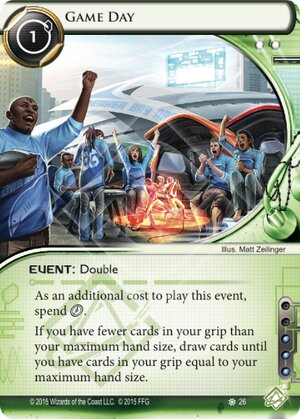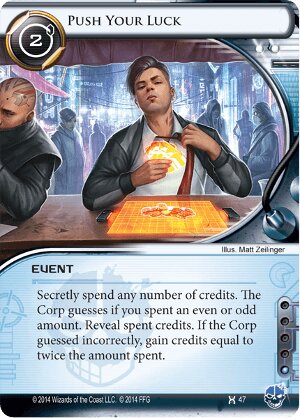Note for lazy readers: The article ends with a request for community feedback on the issues addressed herein. If you want to skip to it, the form is here: https://forms.gle/oNtZCpKDX7yD6cjt6

Articles by Ysengrin and qvm have discussed alternatives to the double-sided swiss (DSS) format that dominates Netrunner tournaments. Both propose single-side swiss (SSS) as an alternative and discuss, among other things, the normative elements that drive the development and adoption of those alternatives. For example, both articles contend that we want to maximize the parity of sides for each player and minimize prestige differences between paired players. But most of the focus is on the mechanics of effectuating SSS rather than how our values should inform important decisions about its implementation. This article is focused on those normative elements and how we might structure their consideration.
These “what is desirable?” questions are worth considering for two reasons:
- Some of the desirable characteristics of the format will necessarily be in opposition. This means we not only need to gain a collective understanding of what individual objectives we want to accomplish, we also need to understand our relative preferences. For example, would we prioritize side parity over prestige matching or vice versa?
- The number of community members who could intelligently create or evaluate the mechanical implementation of a SSS matching algorithm is relatively small. But a much larger number could and should contribute to the decision-making about which objectives/constraints are important.
Below, I pose a number of questions that I hope members of the community will respond to with the intent of informing how to develop and evaluate a SSS matching algorithm.
What problem are we solving?
What is bad about DSS that we hope SSS will fix? Why might we consider abandoning DSS in the first place?
Here are a few drawbacks of DSS that I’ve seen posited:
- The play time of the first DSS game may impact the possible length of the second game
- The format incentivizes “two for one” (241) and “intentional draw” (ID) agreements between players
Are there others? And are any of these more or less important?
Community Question 1: What undesirable outcomes does the DSS system create?
Why do we care about the length of the second game?
The answer here is pretty straightforward and probably doesn’t beg a lot of analysis. In its most extreme DSS version, this phenomenon manifests as a long-playing deck (or both decks) completely eliminating the possibility of the second game. Even without going all the way to time, a long-running first game could all but guarantee the second game will be decided on scored/stolen agenda points rather than whether either player actually achieved a win condition.
Does SSS solve this problem?
SSS solves this problem entirely, giving each individual game the exact same maximum length.
Yay.
Why do we care about 241s and IDs?
Some possibilities include:
- It is “unfair” if a player is able to place highly despite playing few games (241s mean two games become one) or even fewer games (IDs means two games become zero).
- 241s may create divergence from the side balance that is ostensibly a defining feature of DSS. Additionally, that potential divergence increases the more 241s a player engages in.
- Both may undermine the collection and accuracy of tournament results.
- Both may confuse newer players.
- Responding to a request for a 241 or ID might be uncomfortable for a player.
But are these the only ones? Are any of them more or less important?
Community Question 2: Why are two for one and intentional draw matches in DSS a bad thing?
Does SSS solve any of these problems?
The answer here is mixed. Barring collusion between large numbers of players, the 241 concept cannot exist in SSS. So that’s a box checked. But there is no structural barrier to players agreeing to an ID, at least in a certain sense. It may be true that there is no ability, barring collusion, to “split” two games like in DSS but players could still agree to an intentional tie of a single game. I will refer to these “intentional ties” (IT) rather than draws. The important question is whether SSS might change the prevalence or impact of these intentional arrangements. At the very least, the marginal impact of a single IT should be less than an ID since only two points is at stake instead of three.
The removal of 241s should reduce the number of “not played” games and therefore partially mitigate our concern. But would these ITs be a problem?
Game Theory Question 1: Would a rational actor pursue “intentional ties” in SSS? How often?
This question needs to be answered before we can fully judge the extent to which SSS addresses our “played very few games” and “skews meta results” issues.
But we can unequivocally address whether SSS eliminates the “new player confusion” and “uncomfortable being asked” issues since we know at least ITs may still exist. But, as above, their prevalence may be reduced by some amount. My own guess is that it would be rare, relative to DSS.
Finally, the impact on “high placing with few games” and “skews results” also depends on whether byes exist in SSS and, if so, whether they waive only the first game, the first two or do something else.
Community Question 3: Should byes be offered in a SSS format? If so, should they waive one or two games? Or provide some other benefit like starting side choice?
The other big problem: How do you match players?

Most of the normative discussion in qvm and Ysengrin’s articles is focused on the desired parameters of a matching system and its mechanics rather than the macro issues discussed above. This is another area where the preferences of community members should guide us.
Both articles present a list of objectives:
qvm:
- Everyone plays Runner and Corp an equal amount of time
- Runner and Corp games should be spread out throughout the tournament
- Pairing should be according to prestige as good as possible. This means that after we ensure requirements 1 and 2, we try to optimize this one
- There needs to be some way to disincentivize going to time
Ysengrin:
- Would rank players by their skill level to a reasonable degree of accuracy
- Ensure that most people got to play their two decks an equal number of times
- It could be done in the same amount of time as double sided swiss (DSS)
For simplicity’s sake, I combine the two lists here with some edits. I’ve also added some objectives that are otherwise implied in the articles:
- We should minimize the number of times a single player faces the same player
- We should maximize the side parity of players
- We should minimize the number of consecutive games played using the same side
- We should minimize prestige differences between paired players
- We should minimize the length of time provided for each game
- We should minimize the number of games that aren’t completed in the allotted time
- We should maximize the correlation between how well a player performs and their final ranking
Some of these are directly opposed to one another, so we should try to understand the community’s relative preferences in this list and, ideally, the weight of those preferences. As above, we’ll also want to know whether this list has missed any other important objectives or constraints.
Community Question 4: What objectives should we pursue when matching players in SSS?
Community Question 5: Which of these objectives do we care about more than others? What order would you put them in?
One useful way of considering these options is to consider them in opposition. Here are a few examples.
Community Question 5a: Would you rather sometimes face a player of similar record more than once or always face different players but sometimes with a better or worse record? Would you be willing to sacrifice side parity if it meant more matches played with players with a similar record?
Community Question 5b: Would you rather play the same side repeatedly but at parity with the other side or have more alternation between sides at the expense of final side parity?
Finally, we must ask whether our preference to not face the same player is about facing a player or a player/deck combination.
Community Question 6: In SSS, should we minimize the number of times players face each other or the number of times a players deck faces another player’s deck?
What’s next?
If you have thoughts on any of the questions above, or want to raise new ones, you can use this form: https://forms.gle/oNtZCpKDX7yD6cjt6
My hope is to integrate the responses and any other community feedback into an updated version of this article. Stay tuned!
-JayP
——–




